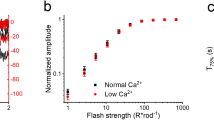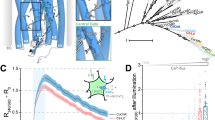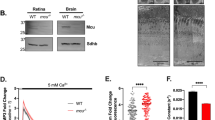Abstract
Measurement of the free calcium concentration within a photo-receptor outer segment has been considered an important aim since the proposal by Hagins and Yoshikami1,2 that the primary event in phototransduction is a release of Ca2+ inside the cell. More recent evidence3–6 has cast doubt on the calcium hypothesis, and the observations of Yau and Nakatani7 and Matthews et al.6 suggest that the internal Ca2+ concentration ([Ca2+]i) may decrease after a flash of light. In the present study we have measured [Ca2+]i directly by using a new method for incorporating the Ca-sensitive photoprotein aequorin into an isolated rod. We report that the light response is accompanied by a decrease in [Ca2+]i, caused by the closure of light-sensitive channels which are the main route for Ca2+ entry into the outer segment. Of the Ca2+ entering through light-sensitive channels, about 95% is sequestered by a rapid and reversible buffering mechanism. Calcium is removed from the cell by an electrogenic pump3 in which 3 Na+ ions are exchanged for each Ca2+; the pump is highly active and the free Ca2+ in the cell declines with a time constant of ∼0.5 s after a flash of light.
This is a preview of subscription content, access via your institution
Access options
Subscribe to this journal
Receive 51 print issues and online access
$199.00 per year
only $3.90 per issue
Buy this article
- Purchase on Springer Link
- Instant access to full article PDF
Prices may be subject to local taxes which are calculated during checkout
Similar content being viewed by others
References
Hagins, W. A. A Rev. Biophys. Bioengng 1, 131–158 (1972).
Hagins, W. A. & Yoshikami, S. Expl Eye Res. 18, 299–305 (1974).
Yau, K.-W. & Nakatani, K. Nature 311, 661–663 (1984).
Hodgkin, A. L., McNaughton, P. A. & Nunn, B. J. J. Physiol., Lond. 358, 447–468 (1985).
Fesenko, E. E., Kolesnikov, S. S. & Lyubarsky, A. L. Nature 313, 310–313 (1985).
Matthews, H. R., Torre, V. & Lamb, T. D. Nature 313, 582–585 (1985).
Yau, K.-W. & Nakatani, K. Nature 313, 579–582 (1985).
Hamill, O. P., Marty, A., Neher, E., Sakmann, B. & Sigworth, F. J. Eur. J. Physiol. 391, 85–100 (1981).
Cobbs, W. H. & Pugh, E. N. Nature 313, 585–587 (1985).
Cervetto, L. & McNaughton, P. A. J. Physiol., Lond. 370, 91–109 (1986).
Capovilla, M., Caretta, A., Cavaggioni, A., Cervetto, L. & Sorbi, R. T. Prog. Retinal Res. 2, 233–247 (1983).
Capovilla, M., Caretta, A., Cervetto, L. & Torre, V. J. Physiol., Lond. 343, 295–310 (1983).
Cervetto, L., McNaughton, P. A. & Nunn, B. J. J. Physiol., Lond. 371, 36P (1986).
Tsien, R. Y. Biochemistry 19, 2396–2404 (1980).
Author information
Authors and Affiliations
Rights and permissions
About this article
Cite this article
McNaughton, P., Cervetto, L. & Nunn, B. Measurement of the intracellular free calcium concentration in salamander rods. Nature 322, 261–263 (1986). https://doi.org/10.1038/322261a0
Received:
Accepted:
Issue Date:
DOI: https://doi.org/10.1038/322261a0
Comments
By submitting a comment you agree to abide by our Terms and Community Guidelines. If you find something abusive or that does not comply with our terms or guidelines please flag it as inappropriate.



